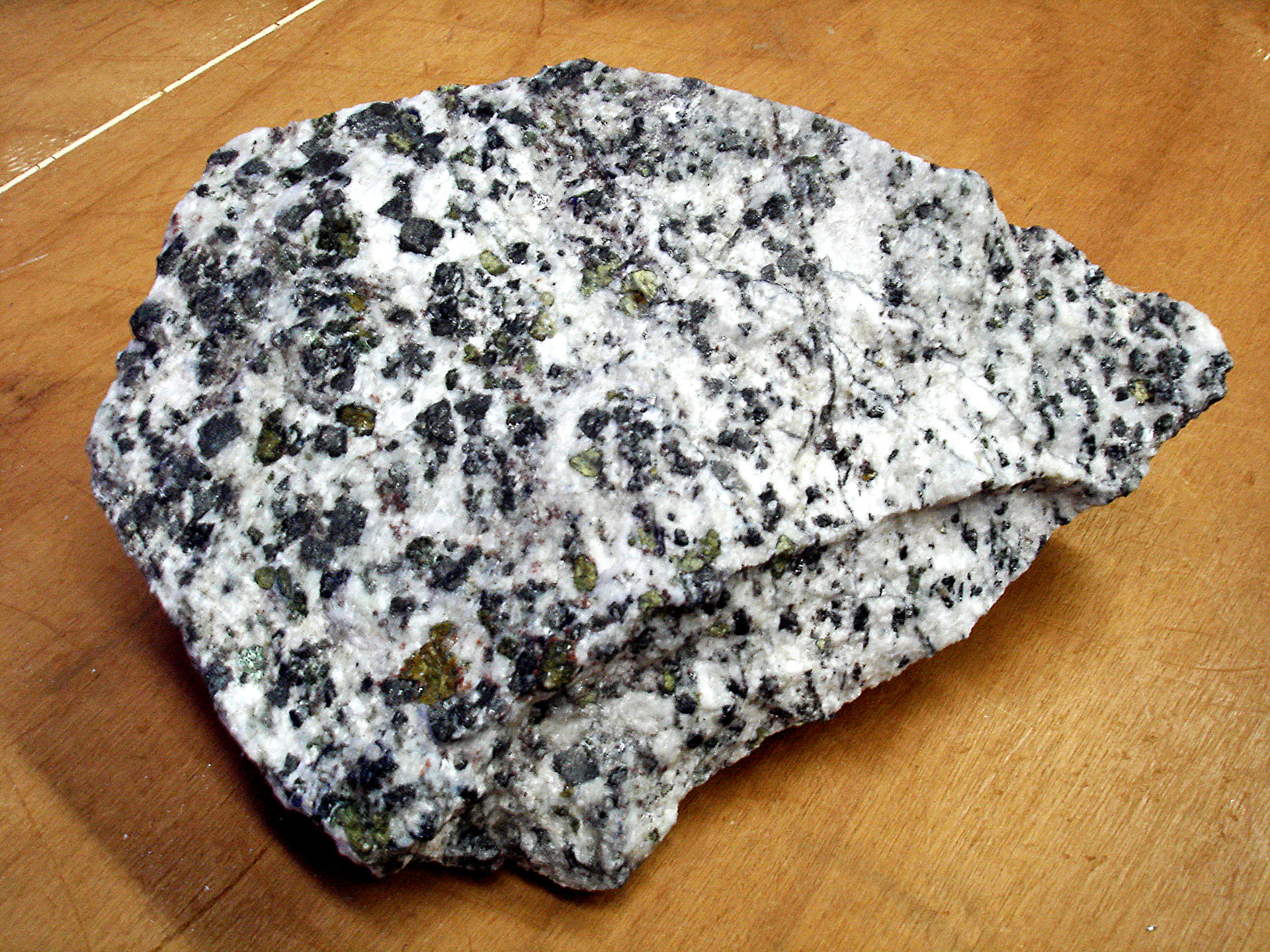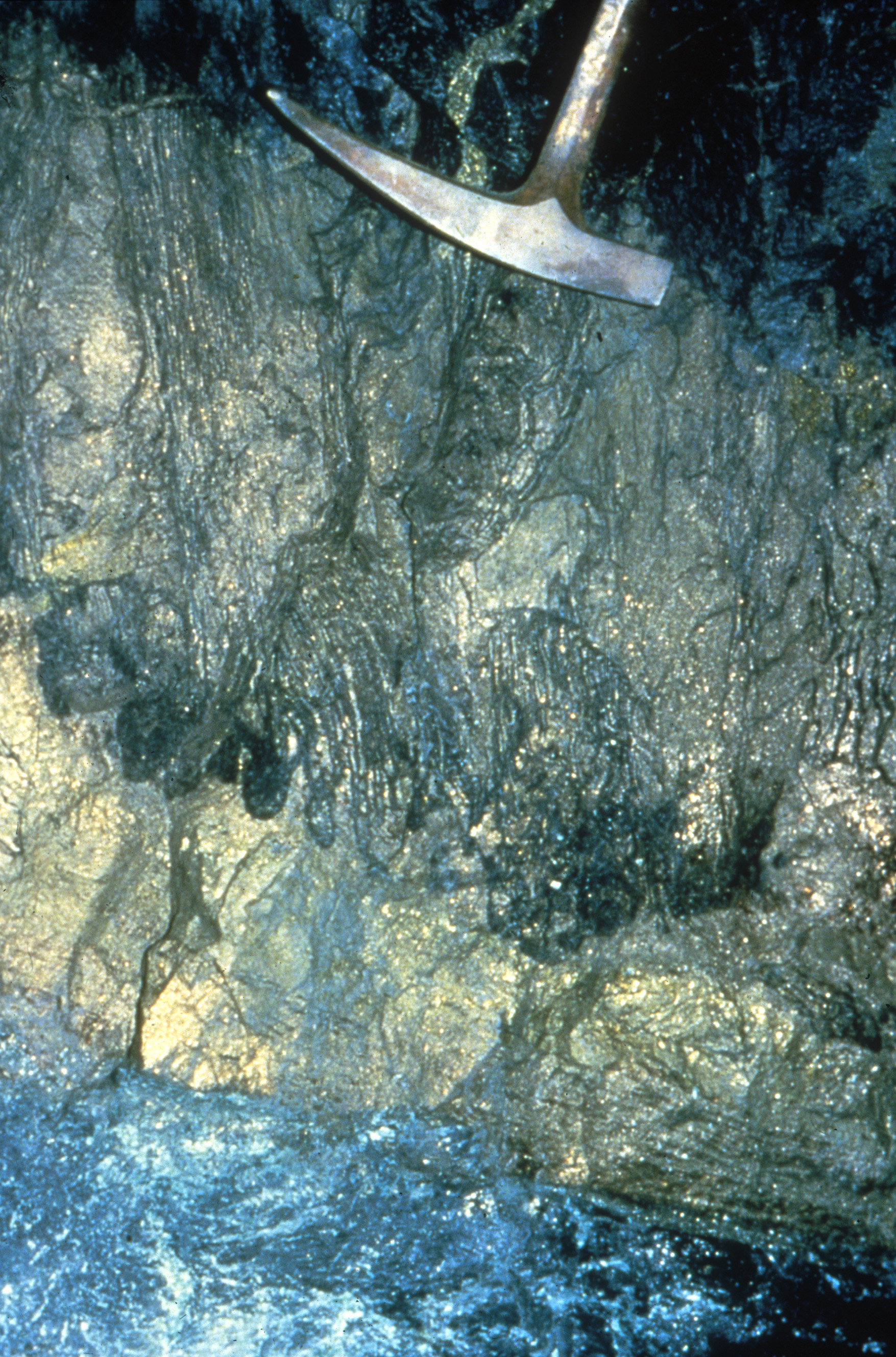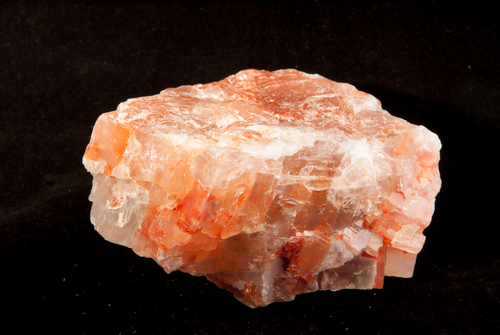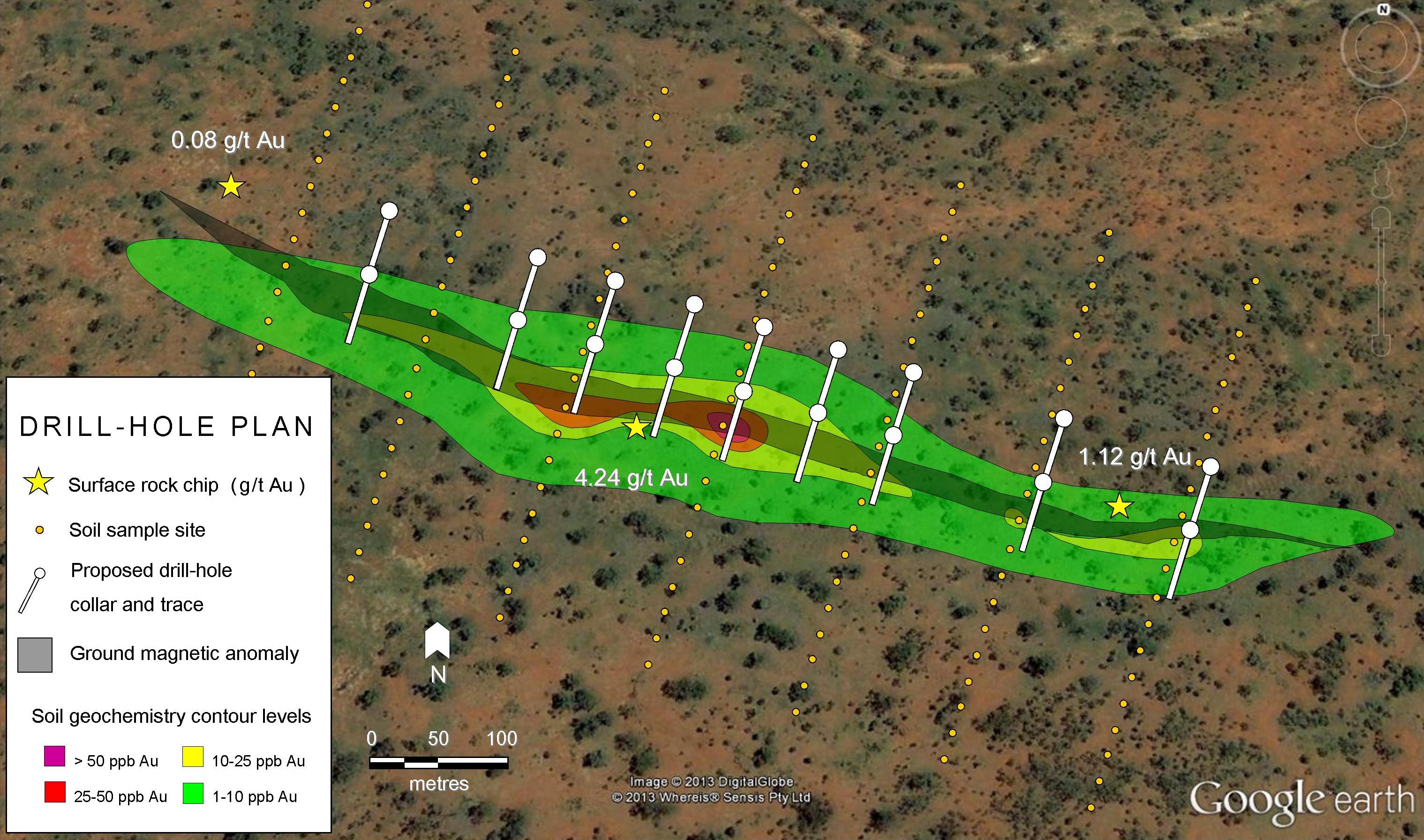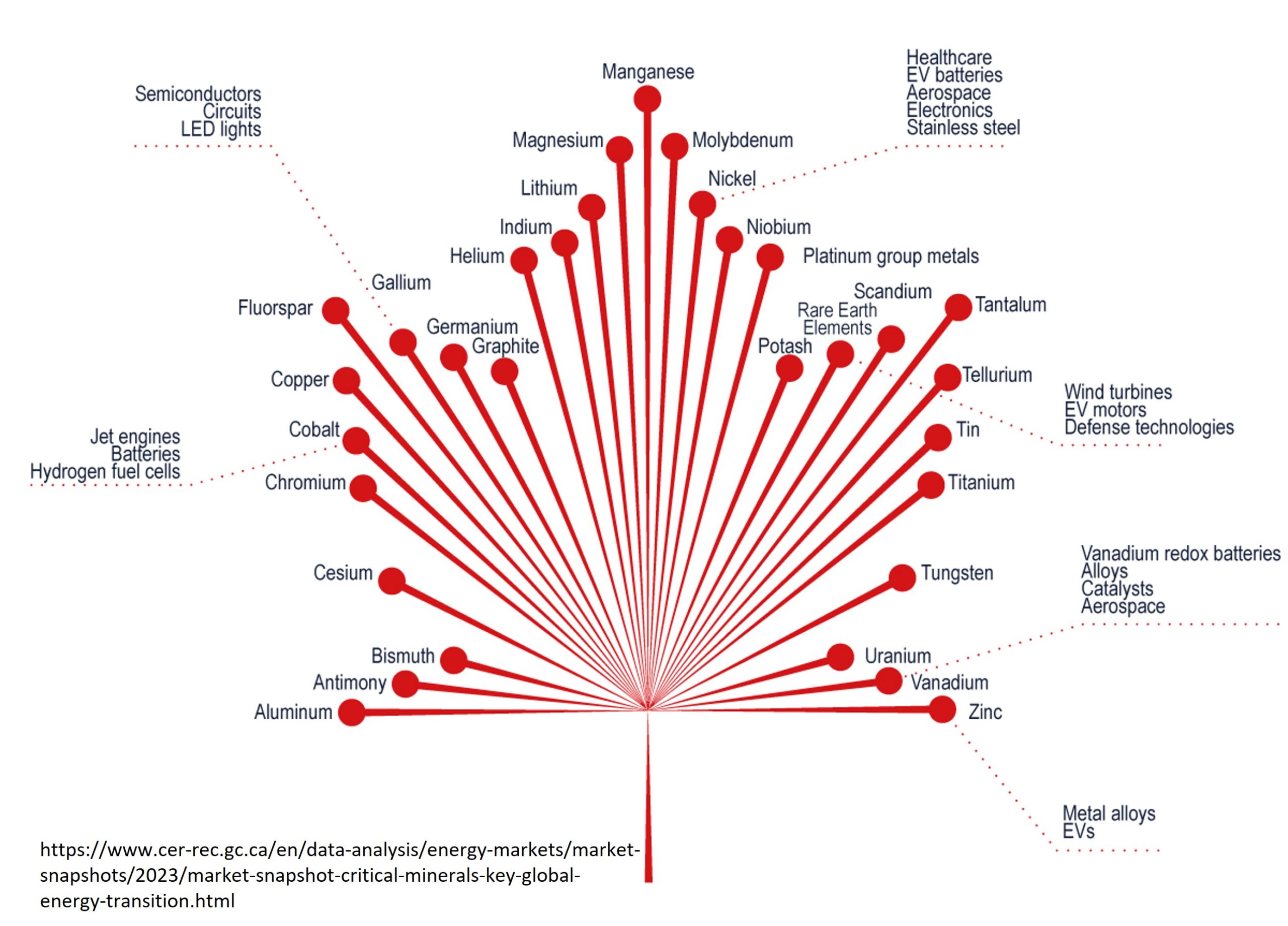Often re-logging and re-sampling can reveal mineralization that was not previously identified. There are many reasons for this. Sometimes the plug is pulled on an exploration program and geologists are told to go home. This can leave untested drill-core in core sheds until the next upswing in exploration activities.
[box type=”info” align=”aligncenter” ]Disclaimer: This is an editorial review of a public press release and not an endorsement. It may include opinions or points of view that may not be shared by the companies mentioned in the release. The editorial comments are highlighted so as to be easily separated from the release text and portions of the release not affecting this review may be deleted. Please view the full release here.[/box]
VANCOUVER, BRITISH COLUMBIA–(Marketwired – Oct. 2, 2013) – TerraX Minerals Inc. (TSX VENTURE:TXR)(FRANKFURT:TX0) is pleased to report further high grade gold assay results from drill core re-logged and re-sampled from its Northbelt property in the Yellowknife gold camp, Northwest Territories. These 16 holes reported today had been drilled at the North Extension Shoot of the Crestaurum deposit, one of numerous gold occurrences on the Northbelt property, and intercepted high-grade gold near surface in several holes. Highlights include:
- 62.90 g/t Au over 5.00 meters in hole 85-150;
- 4.43 g/t Au over 5.00 meters in hole 85-148; and
- 6.55 g/t Au over 2.00 meters in hole 85-151
[box type=”note” align=”aligncenter” ]Below is a map showing the location of the Northbelt property 12km north of Yellowknife, Northwest Territories.[/box]
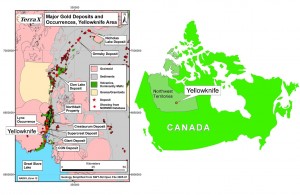
TerraX is currently analyzing core from approximately 200 drill holes previously stored in the core yard at the Giant Mine site in Yellowknife (see news release of July 22, 2013), the assay results from the majority of which have never been reported by prior operators. This historical core included mineralized portions of 74 holes from the Crestaurum deposit that were drilled in 1985 by Giant Mines Ltd. to assist them in open pit and underground planning on the Crestaurum deposit. Due to it’s high grade (see September 18, 2013 release of 13.07 g/t Au over 6.87 m (hole 85-118) and 67.69 g/t Au over 2.00 m (hole 85-157), and September 25th release of 20.66 g/t Au over 5.00 m from drill hole 85-187), the Crestaurum deposit received the vast majority of the historical exploration attention by Giant Mines, including in-fill drilling, advanced mine planning and metallurgical testing. Although already well-defined as a potential resource, the Crestaurum is considered a smaller target than several other shears zones on Northbelt, including the much larger Barney Shear system (see drill hole NB95-16 reported August 14, 2013) for which further drill results from re-assaying of core are pending.
[box type=”note” align=”aligncenter” ]Often re-logging and re-sampling of diamond drill core can reveal mineralization that was not previously identified. There are many reasons for this:
Sometimes the plug is pulled on an exploration program and geologists are told to go home. This can leave untested drill-core in core sheds until the next upswing in exploration activities. I have known of untested drill-core ending up in government collections. When found, these can be a really cheap way of getting “new” results for a company that has taken over control of a property from a previous company. All that is required is some logging and assays, and of course there are no expensive drilling costs for the new company.
Samples may also be logged and assayed over a 3m interval instead of 1m. This can hide thin high grade zones within thicker low grade zones. Re-logging can help identify the thinner zones.
Re-assaying may also be beneficial if a company has previously submitted only quarter core samples. A quarter core sample is a piece of core, usually 1 metre long, that has been cut with a diamond saw blade along the length of the core. Sample representivity can become more of an issue with such small samples. Re-assaying of the other piece of quarter core from the 1 metre interval can often reveal different assay results because the gold may be coarse and not evenly distributed throughout the core.
Different laboratories can produce slightly different assay results too. This is because slightly different sample preparation and assay methods can have an effect on the assay reproducibility.[/box]
The results being reported here are for 16 holes in and near the ‘North Extension Shoot’, an area of higher grade mineralization on the Crestaurum shear that was drilled by Giant Mines in 1985. The North Extension Shoot is 100 m north of 36 drill holes reported September 18th from the ‘North Shoot’, an area adjacent to an exploratory shaft sunk in 1946 to a depth of 400′ (122m), and is the most northerly area previously drilled on the Crestaurum shear. Maps showing the location of the drill results reported here for the North Shoot extension, as well as the recently reported assays from the North, Central and South shoots will soon be available on our web site at www.terraxminerals.com. As previously reported, the free milling nature of the Crestaurum mineralization, as determined by metallurgical testing in 1988, was not conducive to processing in the refractory roaster utilized at the nearby Giant Mine, and thus the deposit was never developed in spite of the high gold grades identified on the property.
[box type=”note” align=”aligncenter” ]Ore shoots are normally long thin zones of high grade mineralization plunging within the plane of a mineralized structure such as a fault or shear. Mineralization within the rest of the structure is usually of relatively low grade compared to the shoot itself. Shoots are formed when a kink or bend forms within the plane of the fault or shear. These are called dilational jogs. Relative rock movements on either side of the structure, such as during earthquakes, results in the creation of an open space where mineralizing fluids can flow into and deposit as vein material. We have drawn a diagram to show how this happens.[/box]

In June of this year TerraX located 123 drill collars at Crestaurum and had the locations surveyed. This included almost all of the 74 holes drilled in 1985, making the discovered drill core from these 74 holes a high priority choice to be re-logged and re-sampled. The core recovered from these 74 holes included most of the mineralized drill core intervals (exceptions noted in table below). Core distances were converted from the original imperial measurements (feet) to metric (meters), and then it was subjected to geological re-logging. New core sampling intervals were designated from the metric measurements based on observed mineralization, but by and large consisted of standard 1 meter sample intervals. Compared to the size of other shears on the property, the logging revealed a relatively narrow zone of alteration (siliceous, carbonate, sericitic, +/- chlorite) and shearing with many holes displaying quartz veining and mineralization (pyrite, arsenopyrite, galena, sphalerite, chalcopyrite and stibnite). Several drill holes displayed visible gold as fine grained aggregates or millimeter scale grains, generally within quartz, but occasionally seen in sheared host rock.
[box type=”note” align=”aligncenter” ]Drill-hole collar locations within old company reports can be out as much as 100 metres or more from their true location. In recent reports, especially since the 1990’s when the Global Positioning System (GPS) was first introduced, locations are much more accurate, i.e. within ±15 metres. When a drill-hole is completed, a short length of PVC tubing is inserted into the drill-hole and a cap is placed over the end. When an old drill-hole collar is found in the field, the location is “picked up” with a hand-held GPS or even better with a differential GPS (DGPS). An accuracy of about ±10 centimetres is achievable with DGPS.
Re-logging the core helps with standardizing rock unit descriptions and names. This is essential when rock unit descriptions and names are imported into drill-hole logging software. Cross-sections and 3-dimensional models of geology can then be constructed automatically without any errors.[/box]
TerraX believes these assay results provide further confirmation of this important zone of mineralization at Crestaurum, which remains open in all directions and down dip. All holes from the North Shoot Extension area are listed below and are categorized into “Inside Shoot” and “Outside Shoot” based on interpretations of the zones done by Giant Mines in 1988. The table includes comment on issues concerning a few holes with missing core in the mineralized zones, and comment on spatial location of holes outside the shoot. It should be noted that drill holes outside the shoot remain significantly mineralized, and TerraX will continue to assess these results with a view of modeling the entire Crestaurum mineralized zone for future exploration.
| Assay Intervals from Crestaurum | |||||||
| Inside North-Ext Shoot | |||||||
| Drill Hole | FROM (m) |
TO (m) |
Width (m) |
Au g/t | Comment | ||
| DDH85-125 | 108.00 | 115.00 | 7.00 | 0.72 | |||
| incl. | 112.00 | 114.00 | 2.00 | 1.52 | |||
| DDH85-148 | 70.00 | 75.00 | 5.00 | 4.43 | |||
| DDH85-150 | 52.00 | 59.00 | 7.00 | 45.05 | |||
| incl. | 53.00 | 58.00 | 5.00 | 62.90 | |||
| DDH85-151 | 86.00 | 89.00 | 3.00 | 4.59 | |||
| incl. | 86.00 | 88.00 | 2.00 | 6.55 | |||
| DDH85-163 | 70.00 | 78.00 | 8.00 | 1.73 | |||
| incl. | 71.00 | 75.00 | 4.00 | 3.00 | |||
| Outside North-Ext Shoot | |||||||
| Drill Hole | FROM (m) |
TO (m) |
Width (m) |
Au g/t | Comment | ||
| DDH85-122 | No significant assays | Between North Shoot and North Extension | |||||
| DDH85-123 | Core from mineralized interval lost | Between North Shoot and North Extension | |||||
| DDH85-130 | 102.00 | 105.00 | 3.00 | 0.16 | Between North Shoot and North Extension | ||
| DDH85-146 | 46.00 | 51.00 | 5.00 | 1.02 | Between North Shoot and North Extension | ||
| incl. | 47.00 | 49.00 | 2.00 | 1.84 | |||
| DDH85-147 | 67.00 | 69.00 | 2.00 | 2.29 | Between North Shoot and North Extension | ||
| DDH85-153 | 71.83 | 77.25 | 5.42 | 1.24 | North of North-Ext Shoot | ||
| DDH85-155 | 55.00 | 57.00 | 2.00 | 1.32 | North of North-Ext Shoot | ||
| DDH85-156 | 107.00 | 108.81 | 1.81 | 1.41 | North of North-Ext Shoot, mineralized zone partially missing | ||
| DDH85-158 | 98.00 | 99.97 | 1.97 | 0.83 | North of North-Ext Shoot | ||
| DDH85-160 | 108.00 | 110.00 | 2.00 | 1.91 | North of North-Ext Shoot | ||
| DDH85-161 | 81.38 | 82.00 | 0.62 | 2.94 | North of North-Ext Shoot | ||
[box type=”note” align=”aligncenter” ]There are many drill-holes here that have thin intervals of low to moderate grade. The big exception of course is DDH85-150 which has an average grade of 62.90 g/t gold over a 5-metre interval. This high grade shoot is definitely worth chasing. The thing to note about all these intersections are their relatively shallow depths. This is important as it keeps the initial mining costs down if a decision is made to proceed with any development.[/box]
Orientation of the Crestaurum Zone is well defined by 187 drill holes (average 035º strike and average 50º dip), and therefore it is confidently known that the drill intersections are close to true thickness, ranging from 85%-100% true width.
[box type=”note” align=”aligncenter” ]It looks like TerraX has a good handle on the true thicknesses of their drill-hole intersections. The greater the number of drill-holes there are the greater is the confidence in the orientation of structures and associated mineralization.[/box]
TerraX collected 170 samples for assay from the drilling in the North Shoot Extension area. Individual assay results ranged from below detection to a high of 216 g/t Au. Best results were obtained in areas of good quartz veining. Core samples were cut with a diamond saw blade. Sampling generally was done by quarter core sampling of half sawn core that remained from previous sampling in 1985, although TerraX sampled all of the core that was available, and extended its sampling beyond the previous sample limits. In areas of previous sampling, quarter core samples remain in the core boxes for further examination if required. Newly sampled areas have one half core remaining.
[box type=”note” align=”aligncenter” ]Below is a diagram which shows what is meant by quarter and half core sampling. Half core sampling is always better than quarter core sampling due to the larger sample size. Larger samples are more representative than smaller samples. If the gold is coarse and not evenly dispersed throughout the sample, it is possible to get very high grades on small samples. This is called the “nugget affect”. This affect is well known among resource modellers who routinely exclude the highest values from their models. The 216 g/t Au assay that TerraX obtained on one of their samples could be caused by the “nugget affect”. Good QA/QC programs will usually account for nugget effects and other outliers.[/box]
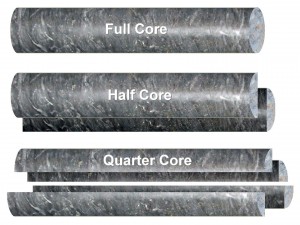
The shear structure containing the Crestaurum mineralization has been drilled for 1400 m of strike length, but the deepest known intersection into the mineralization is less than 150 m vertical depth. The deposit is interpreted to extend further north than the North Extension based on widely spaced drilling with significant gold grades reported in drill logs by previous operators. It has almost no drilling to the south of the South Shoot. The deposit therefore remains open in all directions.
[box type=”note” align=”aligncenter” ]It is unlikely that consistently high gold grades exist along the entire structure. It is more probable that narrow high grade zones or shoots exist only sporadically along the structure. The majority of the structure is likely to be thin and consist of only low-moderate grades.[/box]
Logging and sampling of drill core recovered by Terrax from the Giant Mine site is ongoing, with core from approximately 200 holes now stored at our dedicated core storage facility at the Yellowknife airport. A further 10 holes have been sampled and submitted for re-assay from drilling at Northbelt, with results to be released as soon as possible once they have been input into the drill database. This includes drill holes from the Barney Shear, the 20 Shear, the Milner Lake-Crestaurum Shear area north of the Crestaurum deposit, and holes from the Homer Lake base metal target. In addition, TerraX is awaiting assay results from recently completed surface exploration carried out during September.
Core sampling included insertion of certified standards and blanks. Samples were prepared at ALS Chemex’s laboratory in Yellowknife and shipped to their Vancouver facility for gold and ICP analysis. ALS is a certified and accredited laboratory service.
The technical information contained in this news release has been approved by Joseph Campbell, the President of TerraX, who is a Qualified Person as defined in “National Instrument 43-101, Standards of Disclosure for Mineral Projects.”
The Northbelt gold property encompasses 3,562 hectares on the prolific Yellowknife belt, 15 km north of the city of Yellowknife, and covers 13 km of strike on the northern extension of the geology that contained the Giant (7.6 Moz) and Con (5.5 Moz) gold mines. The Northbelt property is host to multiple shears that are the recognized hosts for gold deposits in the Yellowknife camp and it contains innumerable gold showings.
[box type=”success” align=”aligncenter” ]Have a company or release you’d like us to look at? Let us know though our contact page, through Google+, Twitter or Facebook.[/box]

